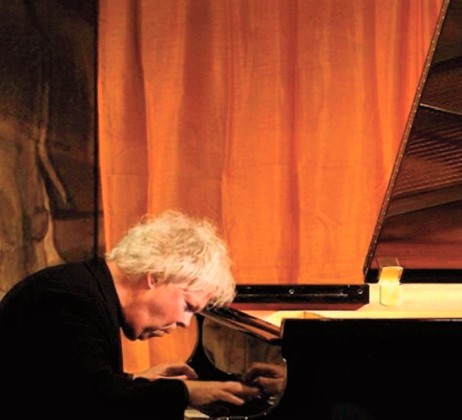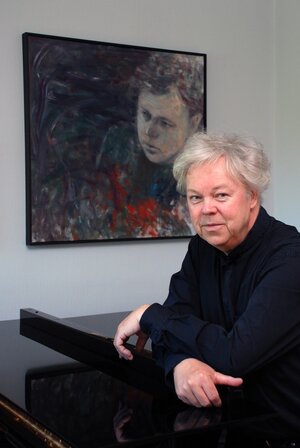
by Kevin T McEneaney
Hans Pålsson, Sweden’s most famous and beloved pianist, is one of this globe’s most accomplished and famous pianists with many recordings on different labels in various countries. I recently heard him (not for the first time) at the annual Gerard Manley Hopkins Festival in Newbridge, Ireland. He opened the concert with Partita No. 1 in E minor, BWV 830 by Johann Sebastian Bach. Critics acclaim this partita as Bach’s greatest as he portrays five types of dances after an introduction: the polite formality of the German Allemande, the light-heated French Corrente, the slower somewhat melancholy Sarabande from Italy, the elegant upper-class French Menuet in ¾ time, concluding with the Celtic Giga, a folkloric mix of soft and hard stepping in rapid 4/4 time. (Bach concluded many works with a forceful gig, as he saw himself socially as a man of the people.) While an organ rendition is usually the best format, the work works well on a modern well-tuned Steinway and Pålsson limned the dances with appropriate nuance, concluding with Celtic zest, announcing his journey from Sweden to Ireland.
Fantasia in C minor, K. 396 (1782) by Wolfgang Amadeus Mozart followed; this was an unfinished piano composition (one of twenty not completed that year), having written only the exposition, then Abbé Stadler later adding development and reprise for pianoforte. This short and delightful piece was both sample and foil to set off stylistic contrast for what came next.
Stylistically speaking, in terms of keyboard style, Haydn was influenced by Clementi (who introduced cross-hand keyboard playing), while Mozart developed a more crystalline style. Mozart eventually appropriated a discursive variation of argument from Haydn, while the influence of Mozart on Haydn broadened Haydn’s harmonic language. Both performers possessed a keen sense of audience and had no fear of being amusing in public, although Haydn was more reserved in his wit.

language. Both performers possessed a keen sense of audience and had no fear of being amusing in public, although Haydn was more reserved in his wit.
In 1789 Haydn wrote a two-movement sonata to celebrate the forthcoming marriage of an Esterházy housekeeper named Maria who was engaged to marry the violinist Johann Tost, a good friend of Haydn, hence the amusing erotic theme. In 1790 Haydn added an Adagio to the sonata, which he described as somewhat difficult when he sent the score to another Maria in England, dedicating the work to her in order to facilitate the likely-hood of an invitation to London, which at that point in time was the largest city in Europe with about a million inhabitants. The upper-class London Maria complained that the elaborate variations in the Adagio presented fingerings too difficult to play, yet the intense erotic intimacy in the work made her fall in love with him. Later in London, Haydn confessed that he might have married the wealthy 60-year-old beauty, yet he was otherwise engaged at the time. I supply this background to indicate the flirtatious nuance of Haydn’s public-private humor found in his Piano Sonata in E-flat, Hob, XVI, played with such brilliant finesse by Hans Pålsson as he captured such plangent, bemused irony in his dexterous fingering of keys. I have heard Haydn piano pieces played well numerous times, yet this stunning performance was one that accurately measured the bemused humor of Haydn in one of his most difficult pieces to play, offering a life-time memory of this superb, aesthetic work.
Two Secherzi, D. 593 by Franz Schubert followed to supply comic relief, an Allegretto in B minor and an Allegro moderato in D major. The first offered a dance motif with high, poignant melody with variations, then a comic lower theme which jostles the higher the melody which arrives back and concludes as witty, delightful riposte. The second is marked “Fairly lively—but not allegro” beginning with a dance rhythm yet wander to explore a mischievous melody only to arrive back with more vigor to acclaim the original dance melody. This was a pleasant foil to set off the concluding performance.

Piano Sonata in C minor Op. 13, named Pathétique by Beethoven himself, composed at the age of 27 when Beethoven was in his Romantic Sturm und Drang period. Later on, C minor would become his heroic key. The search for true pathos opens with heavy Haydnesque chords that repeat, then transmutes to Mozartian lightness, returning to more brooding chords, then unexpected melody arrives; Beethoven appears to synthesize Haydn and Mozart into a new personal format. The second movement is a stoic French funeral march that praises death as the greater communal good, yet here there is a tinge of ironic fate. Hans brought out strongly that echoing irony.
All individual movements were punctuated with searing dramatic pauses by Hans, as if incorporating silence as a movement of music itself. The poetry of Gerard Manley Hopkins likewise employs dramatic moments of silence when read properly; there is a music of dramatic silence in the pacing of his poems. The dramatic pauses Hans took let the audience ponder possible future directions in their lives. In the current context the pathos may be interpreted as the situaotion of Ukrainians dying for their freedom. The performance was deeply personal and soulful. At the age of 73 Hans might have been meditating in public on his own death before an audience that was roughly his own age. This was the most astonishing and dramatic performance I have ever heard of Beethoven. Most classical concerts are quite good, yet every now-and-then a great concert like this becomes imprinted upon one’s memory…..